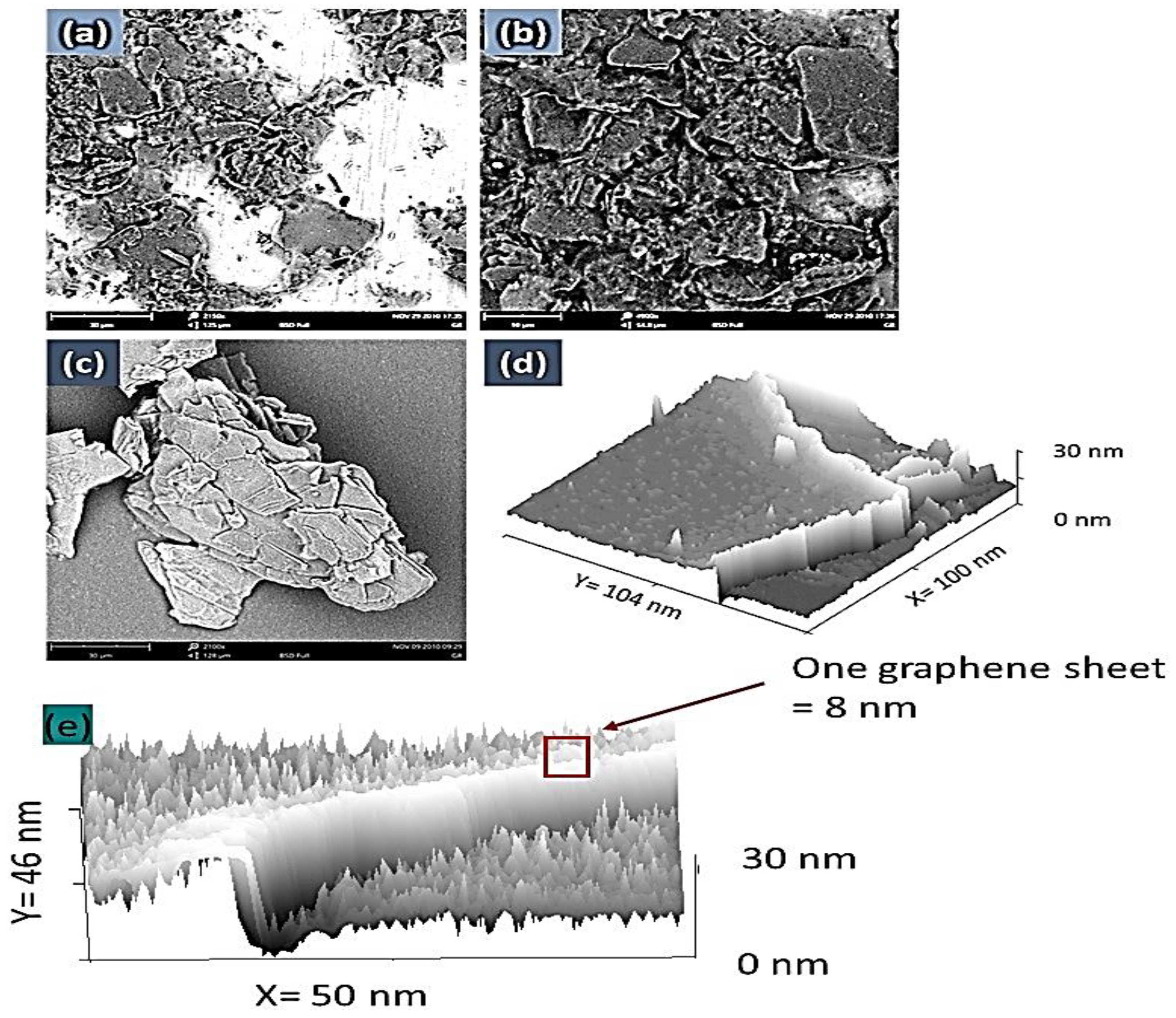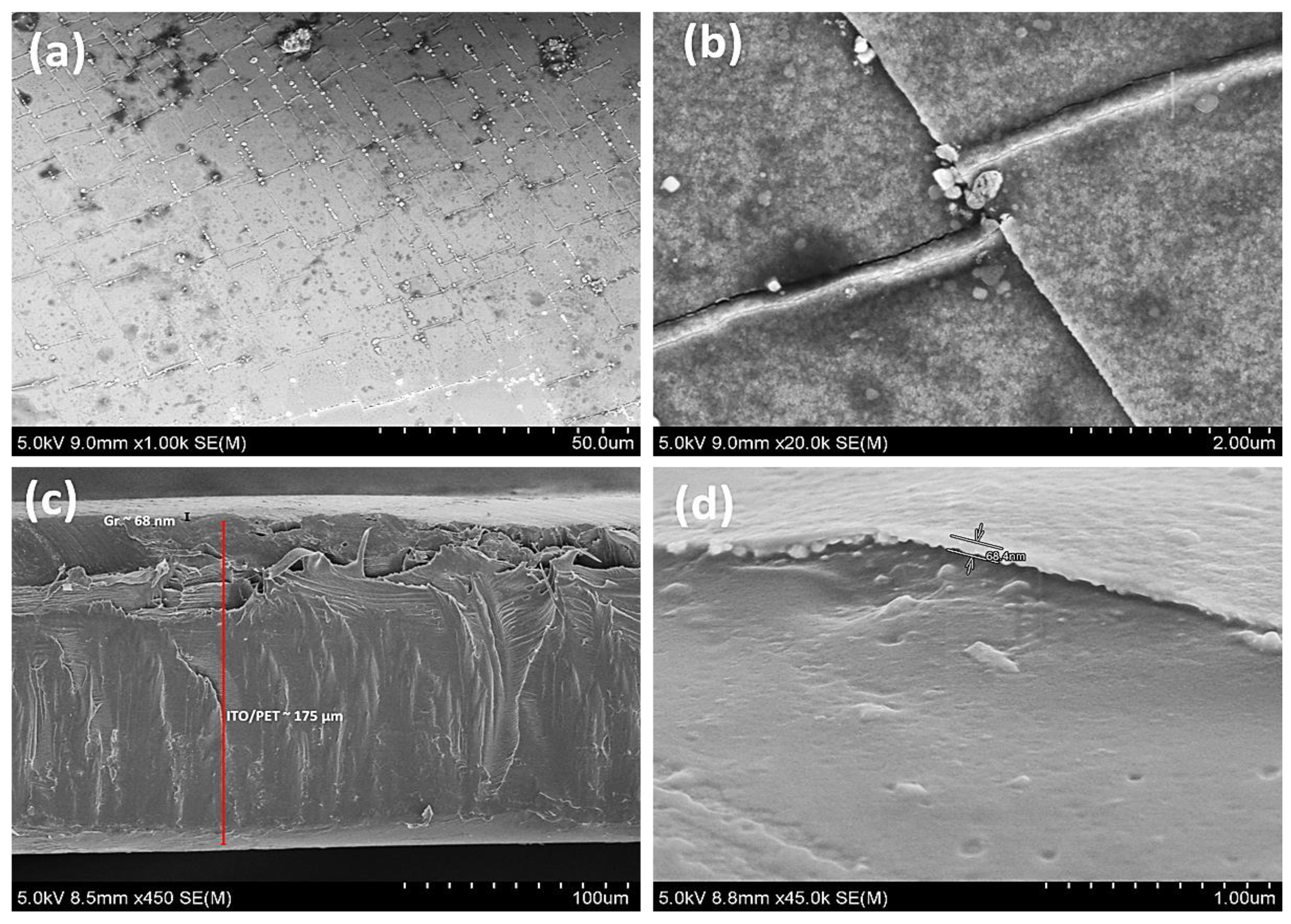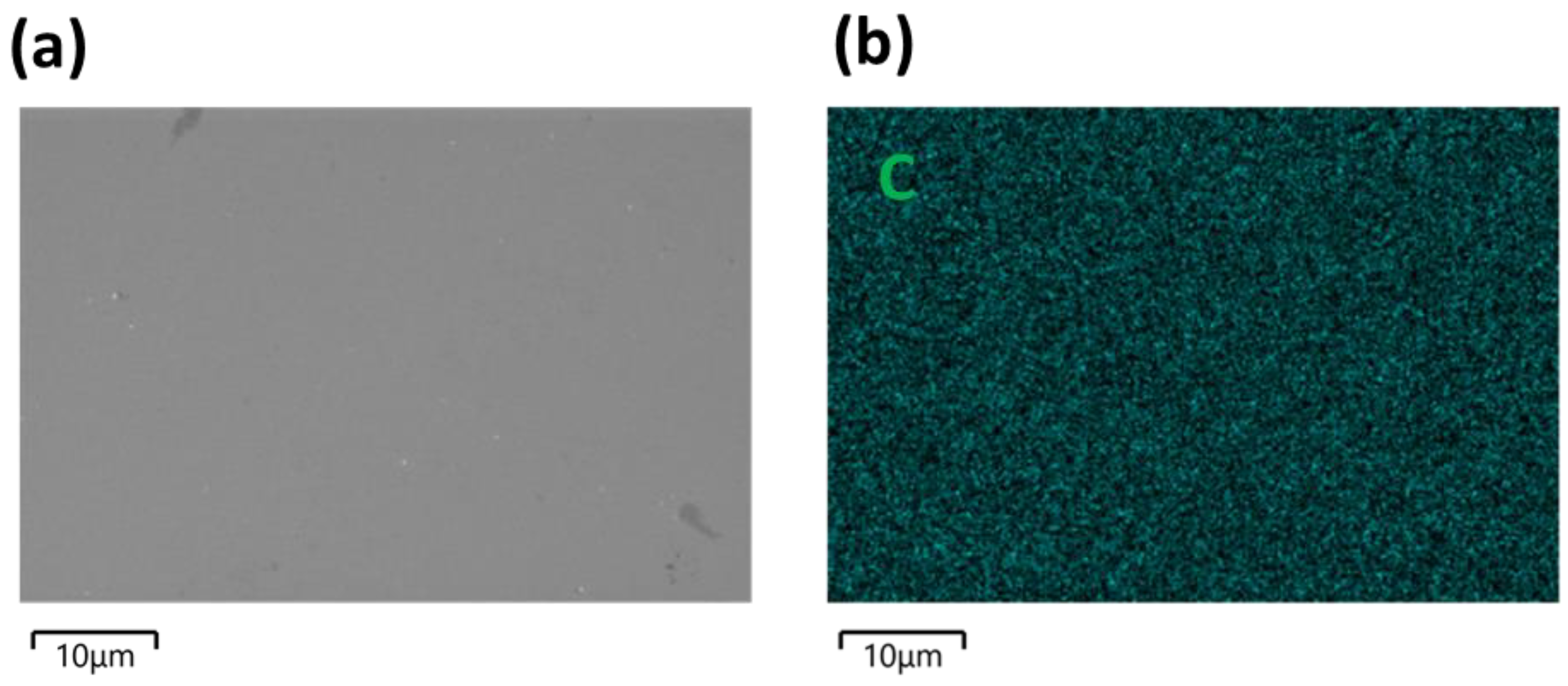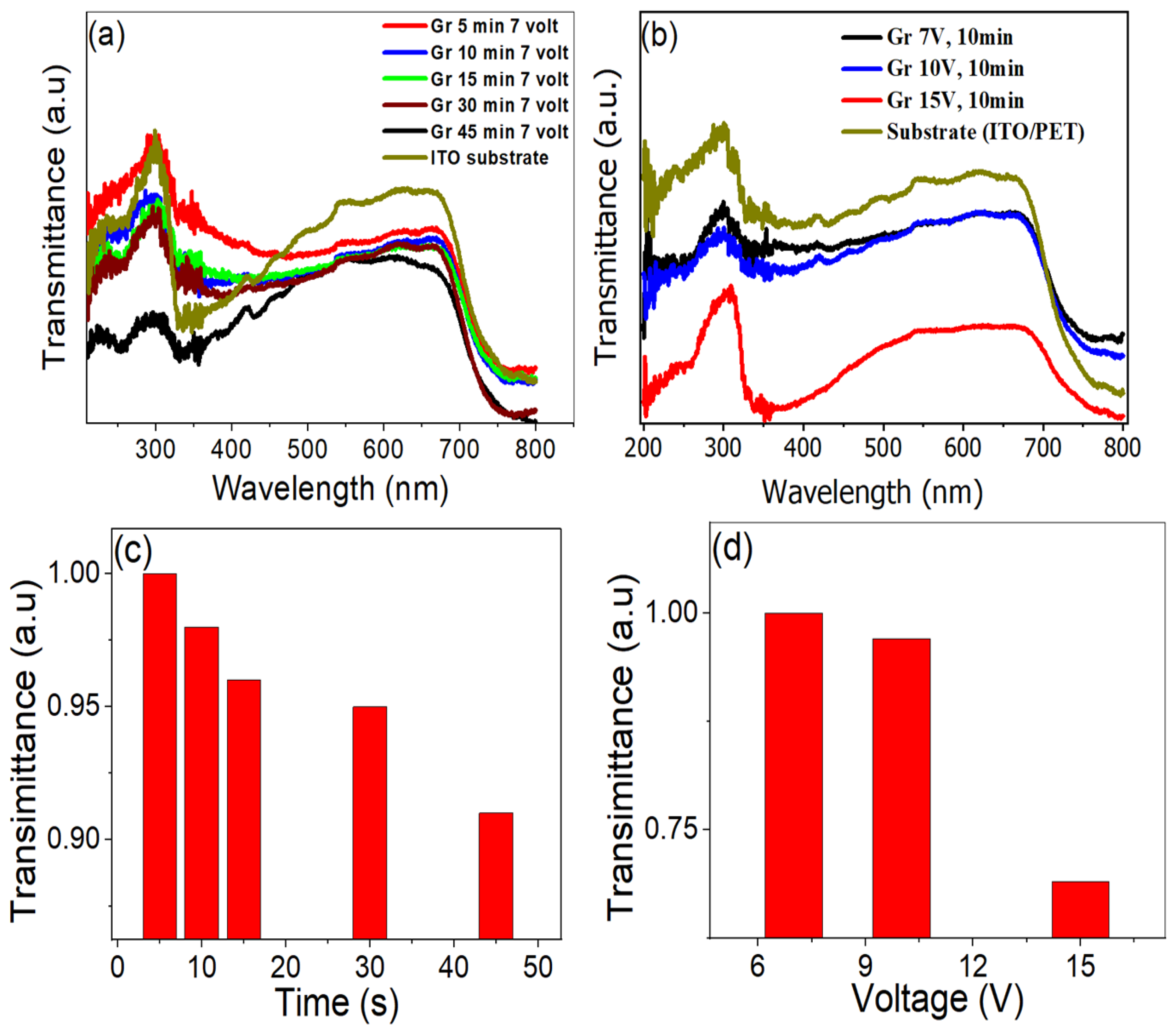Reproducible Preparation of Thin Graphene Films Using a Green and Efficient Liquid-Phase Exfoliation Method for Applications in Photovoltaics
Abstract
:1. Introduction
2. Experimental Section
2.1. G-NS Preparation (Electrophoretic Deposition (EPD) Protocol)
2.2. Characterization
3. Results and Discussion
3.1. Applying EPD for the Prepared Graphene Suspension
3.1.1. Discussion
3.1.2. Results and Discussion: X-ray Diffraction
3.1.3. Results and Discussion—UV–Vis Spectra Analysis
3.2. Monitoring the Deposition Process
3.3. Analyzing Charged Graphene Sheets in the Deposition Process
4. Conclusions
Author Contributions
Funding
Institutional Review Board Statement
Informed Consent Statement
Data Availability Statement
Acknowledgments
Conflicts of Interest
References
- Geim, A.k.; Novoselov, K.S. The rise of graphene, Nanoscience and technology: A collection of reviews. Nature 2010, 1, 11–19. [Google Scholar]
- Coleman, J.N.; Lotya, M.; O’Neill, A.; Bergin, S.D.; King, P.J.; Khan, U.; Young, K.; Gaucher, A.; De, S.; Smith, R.J. Two-dimensional nanosheets produced by liquid exfoliation of layered materials. Science 2011, 331, 568–571. [Google Scholar] [CrossRef]
- Li, X.; Tao, L.; Chen, Z.; Fang, H.; Li, X.; Wang, X.; Xu, J.-B.; Zhu, H. Graphene and related two-dimensional materials: Structure-property relationships for electronics and optoelectronics. Appl. Phys. Rev. 2017, 4, 021306. [Google Scholar] [CrossRef]
- Wang, J.S.; Cao, Y.; Ding, F.; Ma, W.; Sun, M. Theoretical investigations of optical origins of fluorescent graphene quantum dots. Sci. Rep. 2016, 6, 1–5. [Google Scholar] [CrossRef]
- Whitener, K.E., Jr.; Sheehan, P.E. Graphene synthesis. Diam. Relat. Mater. 2014, 46, 25–34. [Google Scholar] [CrossRef]
- Charrier, A.; Coati, A.; Argunova, T.; Thibaudau, F.; Garreau, Y.; Pinchaux, R.; Forbeaux, I.; Debever, J.M.; Sauvage-Simkin, M.; Themlin, J.M. Solid-state decomposition of silicon carbide for growing ultra-thin heteroepitaxial graphite films. J. Appl. Phys. 2002, 92, 2479–2484. [Google Scholar] [CrossRef]
- Berger, C.; Song, Z.; Li, T.; Li, X.; Ogbazghi, A.Y.; Feng, R.; Dai, Z.; Marchenkov, A.N.; Conrad, E.H.; First, P.N. Ultrathin epitaxial graphite: 2D electron gas properties and a route toward graphene-based nanoelectronics. J. Phys. Chem. B 2004, 108, 19912–19916. [Google Scholar] [CrossRef]
- Berger, C.; Song, Z.; Li, X.; Wu, X.; Brown, N.; Naud, C.; Mayou, D.; Li, T.B.; Hass, J.; Marchenkov, A.N.; et al. Electronic confinement and coherence in patterned epitaxial graphene. Science 2006, 312, 1191–1196. [Google Scholar] [CrossRef] [PubMed]
- Wang, X.; Shi, G. An introduction to the chemistry of graphene. Phys. Chem. Chem. Phys. 2015, 17, 28484–28504. [Google Scholar] [CrossRef]
- Li, D.; Müller, M.B.; Gilje, S.; Kaner, R.B.; Wallace, G.G. Processable aqueous dispersions of graphene nanosheets. Nat. Nanotechnol. 2008, 3, 101–105. [Google Scholar] [CrossRef]
- Shan, C.; Yang, H.; Han, D.; Zhang, Q.; Ivaska, A.; Niu, L. Water-soluble graphene covalently functionalized by biocompatible poly-L-lysine. Langmuir 2009, 25, 12030–12033. [Google Scholar] [CrossRef] [PubMed]
- Coleman, J.N. Liquid-Phase Exfoliation of Nanotubes and Graphene. Adv. Funct. Mater. 2009, 19, 3680–3695. [Google Scholar] [CrossRef]
- Hernandez, Y.; Nicolosi, V.; Lotya, M.; Blighe, F.M.; Sun, Z.; De, S.; McGovern, I.T.; Holland, B.; Byrne, M.; Gun’Ko, J.K.; et al. High-yield production of graphene by liquid-phase exfoliation of graphite. Nat. Nanotechnol. 2008, 3, 563–568. [Google Scholar] [CrossRef] [PubMed]
- Mushfiq, S.W.; Afzalzadeh, R. Verification of experimental results with simulation on production of few-layer graphene by liquid-phase exfoliation utilizing sonication. Sci. Rep. 2022, 12, 9872. [Google Scholar] [CrossRef] [PubMed]
- Rabiei Baboukani, A.; Khakpour, I.; Drozd, V.; Wang, C. Liquid-Based Exfoliation of Black Phosphorus into Phosphorene and Its Application for Energy Storage Devices. Small Struct. 2021, 2, 2000148. [Google Scholar] [CrossRef]
- Baboukani, A.R.; Khakpour, I.; Drozd, V.; Allagui, I. Single-step exfoliation of black phosphorus and deposition of phosphorene via bipolar electrochemistry for capacitive energy storage application. J. Mater. Chem. A 2019, 7, 25548–25556. [Google Scholar] [CrossRef]
- Cayambe, M.; Zambrano, C.; Tene, T.; Guevara, M.; Tubon Usca, G.; Brito, H.; Molina, R.; Coello-Fiallos, D.; Caputi, L.S.; Vacacela Gomez, C. Dispersion of graphene in ethanol by sonication. Mater. Today Proc. 2021, 37, 4027–4030. [Google Scholar] [CrossRef]
- Vacacela Gomez, C.; Tene, T.; Guevara, M.; Tubon Usca, G.; Colcha, D.; Brito, H.; Molina, R.; Bellucci, S.; Tavolaro, A. Preparation of few-layer graphene dispersions from hydrothermally expanded graphite. Appl. Sci. 2019, 9, 2539. [Google Scholar] [CrossRef]
- Usca, G.T.; Hernandez-Ambato, J.; Pace, C.; Caputi, L.; Tavolaro, A. Liquid-phase exfoliated graphene self-assembled films: Low-frequency noise and thermal-electric characterization. Appl. Surf. Sci. 2016, 380, 268–273. [Google Scholar] [CrossRef]
- Dang, T.T.; Pham, V.H.; Hur, S.H.; Kim, E.J.; Kong, B.-S.; Chung, J.S. Superior dispersion of highly reduced graphene oxide in N, N-dimethylformamide. J. Colloid Interface Sci. 2012, 376, 91–96. [Google Scholar] [CrossRef]
- Akhavan, O. The effect of heat treatment on formation of graphene thin films from graphene oxide nanosheets. Carbon 2010, 48, 509–519. [Google Scholar] [CrossRef]
- Kim, J.; Ganorkar, S.; Kim, Y.-H.; Kim, S.-I. Graphene oxide hole injection layer for high-efficiency polymer light-emitting diodes by using electrophoretic deposition and electrical reduction. Carbon 2015, 94, 633–640. [Google Scholar] [CrossRef]
- Neirinck, B.; Fransaer, J.; Van der Biest, O.; Vleugels, O. Aqueous electrophoretic deposition in asymmetric AC electric fields (AC–EPD). Electrochem. Commun. 2009, 11, 57–60. [Google Scholar] [CrossRef]
- Wang, M.; Oh, J.; Ghosh, T.; Hong, S.; Nam, G.; Hwang, T.; Nam, J.-D. An interleaved porous laminate composed of reduced graphene oxide sheets and carbon black spacers by in situ electrophoretic deposition. RSC Adv. 2014, 4, 3284–3292. [Google Scholar] [CrossRef]
- Oh, J.-S.; Kim, S.-H.; Hwang, T.; Kwon, H.-Y.; Lee, T.H.; Bae, A.-H.; Choi, H.R.; Nam, J.-D. Laser-assisted simultaneous patterning and transferring of graphene. J. Phys. Chem. C 2013, 117, 663–668. [Google Scholar] [CrossRef]
- Yang, Y.; Wei, Y.; Guo, Z.; Hou, W.; Liu, Y.; Tian, H.; Ren, T.L. From Materials to Devices: Graphene toward Practical Applications. Small Methods 2022, 6, 2200671. [Google Scholar] [CrossRef]
- Helmy, A.; Rabia, M.; Shaban, M.; Ashraf, A.M.; Ahmed, S.; Ahmed, A.M. Graphite/Rolled Graphene Oxide/Carbon Nanotube Photoelectrode for Water Splitting of Exhaust Car Solution. Int. J. Energy Res. 2020, 44, 7687–7697. [Google Scholar] [CrossRef]
- Lv, R.; Terrones, M. Towards new graphene materials: Doped graphene sheets and nanoribbons. Mater. Lett. 2012, 78, 209–218. [Google Scholar] [CrossRef]
- Wang, H.; Wang, Y.; Cao, X.; Feng, M.; Lan, G. Vibrational properties of graphene and graphene layers. J. Raman Spectrosc. 2009, 40, 1791–1796. [Google Scholar] [CrossRef]
- Ghosh, S.; Nika, D.; Pokatilov, E.A. Balandin, Heat conduction in graphene: Experimental study and theoretical interpretation. N. J. Phys. 2009, 11, 095012. [Google Scholar] [CrossRef]
- Johra, F.T.; Lee, J.W.; Jung, W.G. Facile and Safe Graphene Preparation on Solution Based Platform. J. Ind. Eng. Chem. 2014, 20, 2883–2887. [Google Scholar] [CrossRef]
- Shaban, M.; Rabia, M.; Eldakrory, M.G.; Maree, R.M.; Ahmed, A.M. Efficient Photoselectrochemical Hydrogen Production Utilizing of APbI3 (A = Na, Cs, and Li) Perovskites Nanorods. Int. J. Energy Res. 2021, 45, 7436–7446. [Google Scholar] [CrossRef]
- Abdelazeez, A.A.A.; Trabelsi, A.B.G.; Alkallas, F.H.; Rabia, M. Successful 2D MoS2 Nanosheets Synthesis with SnSe Grid-like Nanoparticles: Photoelectrochemical Hydrogen Generation and Solar Cell Applications. Sol. Energy 2022, 248, 251–259. [Google Scholar] [CrossRef]
- Alkallas, F.H.; Elsayed, A.M.; Trabelsi, A.B.G.; Rabia, M. Quantum Dot Supernova-like-Shaped Arsenic (III) Sul-fide-Oxide/Polypyrrole Thin Film for Optoelectronic Applications in a Wide Optical Range from Ultraviolet to In-frared. Catalysts 2023, 13, 1274. [Google Scholar] [CrossRef]
- Shaban, M.; Rabia, M.; Fathallah, W.; El-Mawgoud, N.A.; Mahmoud, A.; Hussien, H.; Said, O. Preparation and Characterization of Polyaniline and Ag/Polyaniline Composite Nanoporous Particles and Their Antimicrobial Activities. J. Polym. Environ. 2017, 26, 434–442. [Google Scholar] [CrossRef]
- Abdelazeez, A.A.A.; Hadia, N.M.A.; Mourad, A.H.I.; El-Fatah, G.A.; Shaban, M.; Ahmed, A.M.; Alzaid, M.; Cherupurakal, N.; Rabia, M. Effect of Au Plasmonic Material on Poly M-Toluidine for Photoelectrochemical Hydrogen Generation from Sewage Water. Polymers 2022, 14, 768. [Google Scholar] [CrossRef] [PubMed]
- Rabia, M.; Shaban, M.; Jibali, B.M.; Abdelkhaliek, A.A. Effect of Annealing Temperature on the Photoactivity of ITO/VO 2 (M)/Au Film Electrodes for Water Splitting. J. Nanosci. Nanotechnol. 2020, 20, 4120–4130. [Google Scholar] [CrossRef]
- Michael, L.; Kamyshny, A.; Magdassi, S. Transparent conductors composed of nanomaterials. Nanoscale 2014, 11, 5581–5591. [Google Scholar]
- Qingbin, Z. Graphene oxide-based transparent conductive films. Prog. Mater. Sci. 2014, 64, 200–247. [Google Scholar]
- Shaban, M.; Ali, S.; Rabia, M. Design and Application of Nanoporous Graphene Oxide Film for CO2, H2, and C2H2 Gases Sensing. J. Mater. Res. Technol. 2019, 8, 4510–4520. [Google Scholar] [CrossRef]
- Shuping, P. Graphene as transparent electrode material for organic electronics. Adv. Mater. 2011, 23, 2779–2795. [Google Scholar]
- Francesco, B. Graphene photonics and optoelectronics. Nat. Photonics 2010, 4, 611–622. [Google Scholar]
- Xiao, H. Graphene-based electrodes. Adv. Mater. 2012, 24, 5979–6004. [Google Scholar]
- Wengang, L. Gate tuning of high-performance InSe-based photodetectors using graphene electrodes. Adv. Opt. Mater. 2015, 3, 1418–1423. [Google Scholar]
- Di, W. Highly polarization-sensitive, broadband, self-powered photodetector based on graphene/PdSe2/germanium heterojunction. ACS Nano 2019, 13, 9907–9917. [Google Scholar]
- Hui, Q. Self-powered photodetectors based on 2D materials. Adv. Opt. Mater. 2020, 8, 1900765. [Google Scholar]
- Jacobs-Gedrim, R.B. Extraordinary photo response in two-dimensional In2Se3 nanosheets. ACS Nano 2014, 8, 514–521. [Google Scholar] [CrossRef]
- Ben Gouider, A.B. Morphological imperfections of epitaxial graphene: From a hindrance to the generation of new photo-responses in the visible domain. Nanoscale 2017, 9, 11463–11474. [Google Scholar] [CrossRef]
- Ursula, K. Semiconductor saturable absorber mirrors (SESAM’s) for femtosecond to nanosecond pulse generation in solid-state lasers. IEEE J. Sel. Top. Quantum Electron. 1996, 2, 435–453. [Google Scholar]
- Binglei, Z. Photon Drag Currents and Terahertz Generation in α-Sn/Ge Quantum Wells. Nanomaterials 2022, 12, 2892. [Google Scholar]
- Isaac, L. Graphene–metamaterial photodetectors for integrated infrared sensing. ACS Photonics 2016, 3, 936–941. [Google Scholar]
- Konstantin, S.N. A roadmap for graphene. Nature 2012, 490, 192–200. [Google Scholar]
- Forrester, D.M.; Kusmartsev, F.V. Electron quantum optics with beam splitters and waveguides in dirac matter. Adv. Quantum Technol. 2023, 6, 2300112. [Google Scholar] [CrossRef]







Disclaimer/Publisher’s Note: The statements, opinions and data contained in all publications are solely those of the individual author(s) and contributor(s) and not of MDPI and/or the editor(s). MDPI and/or the editor(s) disclaim responsibility for any injury to people or property resulting from any ideas, methods, instructions or products referred to in the content. |
© 2023 by the authors. Licensee MDPI, Basel, Switzerland. This article is an open access article distributed under the terms and conditions of the Creative Commons Attribution (CC BY) license (https://creativecommons.org/licenses/by/4.0/).
Share and Cite
Adel A. Abdelazeez, A.; Trabelsi, A.B.G.; Alkallas, F.H.; AlFaify, S.; Shkir, M.; Alrebdi, T.A.; Almugren, K.S.; Kusmatsev, F.V.; Rabia, M. Reproducible Preparation of Thin Graphene Films Using a Green and Efficient Liquid-Phase Exfoliation Method for Applications in Photovoltaics. Coatings 2023, 13, 1628. https://doi.org/10.3390/coatings13091628
Adel A. Abdelazeez A, Trabelsi ABG, Alkallas FH, AlFaify S, Shkir M, Alrebdi TA, Almugren KS, Kusmatsev FV, Rabia M. Reproducible Preparation of Thin Graphene Films Using a Green and Efficient Liquid-Phase Exfoliation Method for Applications in Photovoltaics. Coatings. 2023; 13(9):1628. https://doi.org/10.3390/coatings13091628
Chicago/Turabian StyleAdel A. Abdelazeez, Ahmed, Amira Ben Gouider Trabelsi, Fatemah. H. Alkallas, Salem AlFaify, Mohd. Shkir, Tahani A. Alrebdi, Kholoud S. Almugren, Feodor V. Kusmatsev, and Mohamed Rabia. 2023. "Reproducible Preparation of Thin Graphene Films Using a Green and Efficient Liquid-Phase Exfoliation Method for Applications in Photovoltaics" Coatings 13, no. 9: 1628. https://doi.org/10.3390/coatings13091628





